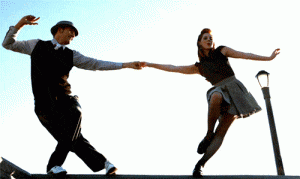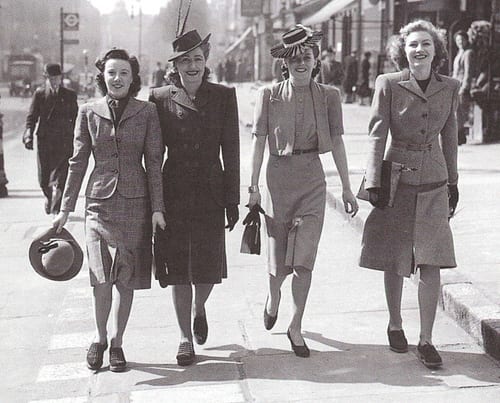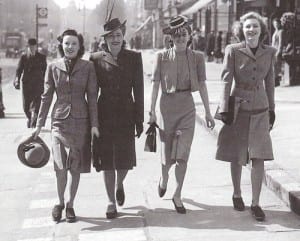Here come the girls!

 There’s a swinging revolution sweeping the country and Laura Knight is at the centre of it as one of the founders of Girl Jam, a vintage-inspired dance weekend. Stacey Cosens talks to her about why swing dancing is making a big comeback.
There’s a swinging revolution sweeping the country and Laura Knight is at the centre of it as one of the founders of Girl Jam, a vintage-inspired dance weekend. Stacey Cosens talks to her about why swing dancing is making a big comeback.
Think back to the grainy black and white films starring Fred Astaire and Ginger Rogers, with their flawless dance numbers, excellent chemistry and beautiful clothes. How many times have you watched those romantic films and wished you could be part of the 1930s or 1940s, with its formal dances and Hollywood glamour? It seems like the days of swing dancing are in the past, but dig deeper into the underground world, and you’ll see it’s alive and kicking.
A graphic designer, Laura fell into the world of swing five years ago, when she spotted a couple dancing and delved deeper into its underground world.
“I looked up a class and I found one really near where I work, and from there I was hooked.” Laura explains “I teach it now, I have for a couple of years. There’s a whole scene, it happens in most cities around the UK. It’s highly addictive.”
“I would say most major cities have a fairly large swing scene, Bristol has a swing scene, Leeds, Manchester, you find them in most places.”
“It’s a really sociable, it’s a very fun dance, its not like ballroom, its not about posture, and its not got the same kind of feel to it that salsa has. People enjoy it, sometimes the vintage aspect, and dressing up. Mostly it’s just a really fun dance.”
It was the social aspect of swing dancing that spurred Laura into organising the Girl Jam weekend.
“There was me and a couple of other girls that swing dance and do lindy hop, which is partnered dancing. Mostly when you do swing dance, you’re doing partnered dancing and because you’re mostly dancing with men, you don’t often to get to meet the other girls on the scene very much.
“So we had this fantastic teacher from Australia, called Annie Ryan, and she does solo jazz and Charleston and there’s another teacher called Peta Cook who’s the same, and we could think of all these amazing teachers and we thought, oh we’ll put an event together that’s just about solo dancing and then it kind of took off really. We could add a disco session, a Go-Go session and we have a friend that does burlesque and teaches that, so it just turned into this entire weekend, it was originally going to be a day. It just started as an idea over coffee and it’s just turned into this monster.”
“I think given the strength it’s had this year, we’ll probably do it again next year, with more teachers and that kind of thing. It’s really just about getting women together and we chose the weekend because its quite close to International Women’s Day, and we thought it would be nice because its mostly about getting women together and dancing and enjoying themselves and building their confidence.”
For its first outing, Girl Jam has been spectacularly popular; with all its places selling out (both beginner and intermediate). The surging popularity in swing and retro events is partly down to the growing world of vintage fashion, and people wanting to tap into the vintage lifestyle.
“We had a big swing ball recently in London, and everybody came really dressed up, the guys love it because they get to dress in suits. It’s sociably acceptable to really dress up.
“We’ve had so many excited emails from people, mostly these groups of friends that have grouped together from Berlin, and we’ve had these two sisters down in London, getting together with their cousins from Newcastle, and it’s the first time they’ve got together in ages.
“The whole thing has been designed with hanging out in mind.
“I guess in the swing dancing world, it’s not often women get to meet each other. And we’ve got beginners, people that have never danced in their life before and 1920s and 1930s is really big at the moment, and people really wanna learn. The main track is the Charleston, and it’s just about people getting together and having a dance really.”
For more information about Girl Jam visit: http://girljam.org/
Swing dancing near you.
If Laura’s Girl Jam weekend has spurred you into wanting to explore the world of swing dancing, here are a few swing dancing classes around the country.
Leeds: Lindy Fridays at The Carriageworks, 3 Millenium Sq, LS2 3AD every Friday for Beginners. Classes are standalone so can be joined any week.
Manchester: Feets of Amazement, Studio 25, 25 Church Street, Manchester, M4 1PE every Monday for Beginners. Drop in classes.
Nottingham: Nottingham Swing Dance Society, Festival Inn, Ilkeston Rd, Trowell, Nottingham NG9 3PX every Tuesday from 8pm.
Edinburgh: Edinburgh Swing Dance Society, Stockbridge House, 2 Cheyne Street, Edinburgh. Classes run from Sept to July, every Thursday.
Bristol: Hoppin’ Mad, Elmgrove centre, every Monday.
Birmingham: Jazz Jive Swing, New Billesley, Brook Lane, Kings Heath, Birmingham, West Midlands, B13 0AB, every Thursday.

